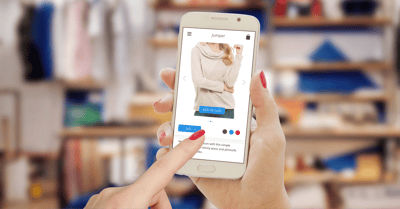Headquarters
175 S Main St Suite 1310,
Salt Lake City, UT 84111

The eCommerce industry is known for constant innovations that change the face of how customers purchase items and how retailers sell their products. Recently, Progressive Web Apps (PWAs) have risen to the forefront of the retail marketplace. What’s a PWA you ask? PWAs are websites with all the benefits of mobile apps and so much more. They are mobile apps delivered through the web, enabling retailers to deliver a faster, more engaging version of their eCommerce websites to their customers.
If this benefit wasn’t enough, why else should you care about PWAs? As discussed in a previous blog, users are downloading fewer mobile apps than in previous years. In addition to this trend, responsive mobile sites are slow, leading to low conversion rates for retailers. PWA technology blends the best of mobile apps and websites by being accessible anywhere on the web without any installation friction compared to installing native apps.
In this blog, we will discuss all of the benefits and features of PWAs and why you should embrace this innovative eCommerce technology.
In 2020, people want instant gratification. If your website doesn’t load in 3 seconds or less, your business is already behind, since 53% of customers will bounce from your site. PWA technology enables companies to create a mobile-first eCommerce site that loads in less than 3 seconds because it works as a local app server on the phone. In non-PWA sites, for example, the entire HTML address and data are rendered from the server, also known as “Server-Side" rendering, which actually increases page load times.
So how does PWA pull off this magic? PWAs use an alternative to Server-Side rendering called Client-Side Rendering. With this approach, the content is rendered on the client’s web browser, and once visitors land on any page, the site is cached in the phone’s memory. This means that when that person loads the same page from the phone, it’s not served from the company server, but their phone’s memory, resulting in a significantly faster page load.
And what happens when your company’s website loads faster? By increasing response times, you will be more likely to increase eCommerce conversions on your site.
The world, not just the eCommerce industry, has gone mobile. Smartphones and tablets are the norms for so many people that retailers should have websites designed for mobile in mind, right? Unfortunately, some businesses designed their sites with the desktop computer in mind; remember those? Although some retailers have taken the approach of responsive web design to address this issue, it’s simply a duct-tape solution.
Design teams need to design native mobile apps for mobile devices. This approach will ensure that the user experience is more engaging compared to a responsive web design, which simply means that websites can run on mobile devices, rather than being designed front to back with mobile in mind.
When implementing PWA technology, the design team should take this opportunity to create a mobile-first experience from the start. In addition to a mobile-first experience, visitors should receive other innovative features when accessing your site. Make sure they can take advantage of offline browsing, push notifications, no reload time when switching pages, and have the ability to save the app as an icon on their home screen. All of these features, combined with an instant page load, make users feel like they’re using a native app, creating a more engaging, enjoyable experience.
Internet connections may seem ubiquitous, but there are plenty of times when the Internet just doesn’t seem to cooperate when you need it most. When the connection drops, you’re likely familiar with the infamous “404 error page.” What if these connection drops and error pages were things of the past? Just imagine commuting on the New York subway and browsing your store’s favorite website without interruption.
PWA technology makes these dreams into a reality by delivering a cached page with previously retrieved data. This means that you can continue browsing while the network connection is down, but you’ll immediately be able to browse new pages once the network is back up and running. This transition from offline to online may only last a few seconds, and there’s also a transition period where the phone believes there’s no active network, thus causing a slight lag.
Although this lag might seem like a doom-and-gloom scenario on the surface, it’s actually an opportunity to deliver an even smoother, more enjoyable user experience. Rather than showing the standard 404 error page, some businesses offer games as the network switches from online to offline. Trivago has perfected this offline browsing process by allowing users to play a game if the network is down. The online travel site has found that 67% of users who experience Internet interruptions still come back to browse their site.
Retailers interested in designing a PWA eCommerce website should design their site in a way that allows customers to check out their items offline and processes the order after a connection is reestablished. This process will ensure shoppers don’t abandon their carts and complete their purchases.
Shopping cart abandonment rates have been a thorn in retailers’ side for some time. The percentages of abandoned online shopping carts stands at nearly 70%, according to statistics compiled by the Baymard Institute. Luckily, one thing’s for sure: PWA technology can minimize the impact of this potentially lost revenue. Like native mobile apps that feature push notifications to engage and re-engage visitors who abandoned their carts, PWAs also offer push notifications for Android phones, and similar functionality will soon be released for iOS.
Push notifications are important tools for any marketing team launching campaigns such as new product arrivals or promotional discounts. The more timely the push notification, the more effective. Don’t send customers discounts for products six months from now; create more urgency around the deal. It’s also critical to track the click-through rate, time spent on the site, and conversion rates for users who received the notifications and those who didn’t to test the notifications’ effectiveness.
To maximize opt-ins, avoid prompting users to opt into the notifications on the website homepage. It’s a best practice to encourage opt-in when they’re buying a product or applying for a discount code, since they’re readily showing interest in your items and company. Your push notifications should only add value to the customer relationship. If shoppers realize the benefits of the push notifications (i.e. they will receive notifications for future discounts), they’re more likely to opt-in.
A person’s mobile home screen is the most valuable piece of digital real estate available to any brand. If your logo is on a customer’s home screen, your brand is exposed to that customer’s friends and family and any strangers who may catch a glimpse. It's free advertising for your business, and it means your website is just one click away.
PWAs have a significant advantage over both mobile native apps and responsive websites because they’re a lot quicker to deploy. For example, potential customers can simply add your PWA to their home screen directly from the browser, which is faster than roaming the Google Apps or Apple App Store to find the right app and download it. With PWAs, your shoppers won’t even need a browser once the web app is added and displayed on their home screen; the PWAs will open full-screen and enable customers to shop freely.
The rise of mobile devices has reshaped how customers search, review, and purchase items online. For searches in particular, customers need to think about how they’re ranking on Google from a mobile perspective. In May 2019, Google announced that mobile-first indexing will be the default option for all new web domains moving forward. What does this mean now for your business? Google is now evaluating only the mobile version of your page for the relevance to a user’s query.
Your business must ensure that all the content you want to be indexed is present on your mobile site. If the content is only included in desktop versions and not visible on the mobile version, this content won’t be indexed by search engine results pages (SERPs). This approach clearly signals that Google wants to provide the best possible user experience on mobile devices and rest assured that Google will be looking at your brand to ensure the mobile version of your website is indeed the main version of your site.
With PWA, you can significantly improve the user experience on mobile devices to match Google’s goal of providing the most relevant search results to customers. This will result in not only a better user experience but also a boost to your SEO rankings and conversion rates. What’s not to love?
Combined, the Apple App and Google Play stores generated 33.6 billion app downloads during the first quarter of 2020 alone. Many retailers and brands add native apps to these app stores thinking their customers might look and download their apps from these stores. But what if there was a more effective way to attract customers? Try wrapping your PWA into a native application, thanks to frameworks like Ionic.
With this strategy in place, you don’t have to manage two teams for web and native apps. Instead, there’s a single code base that can be managed at just one time. Think about all the benefits of this just from an update standpoint. PWAs don’t require updates as native apps do, so your development teams will save precious time avoiding and managing additional updates altogether.
* * *
The eCommerce industry may always evolve, but few market-shifting trends have entered the forefront quite like PWAs. PWA technology has transformed the eCommerce landscape, enabling businesses to improve the mobile user experience, increase average web sessions, boost organic search traffic, and improve conversion rates. All of these features and benefits clearly indicate that PWAs are the future of eCommerce, not simply a fad.
Where should you go from here? The next step in your PWA journey is to select a solution. Some of the major platforms available include Magento’s PWA Studio, ScandiPWA, and Vue Storefront. Magento’s PWA Studio doesn’t offer a ready-to-use solution, but rather a set of tools for building PWA stores that increases the cost of implementation and time to market. ScandiPWA is a ready-to-use PWA theme that is tightly coupled with Magento, and it doesn’t work with other eCommerce platforms such as Salesforce Commerce or Shopify Plus. By choosing PWA Studio or ScandiPWA, you’ll be restricted to the Magento ecosystem.
To avoid these added costs and implementation headaches, Vue Storefront is just what your business needs to hit the ground running with your PWA technology. Backed by a robust, active developer community, Vue Storefront offers open-source PWA for eCommerce that is ready to use now.
HotWax Commerce is an API-first headless commerce solution that is pre-integrated with Vue Storefront, which reduces your cost of implementation and time to market. Contact us today to start your PWA journey off on the right foot.






